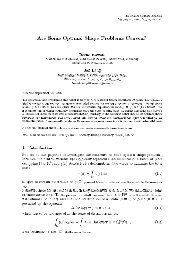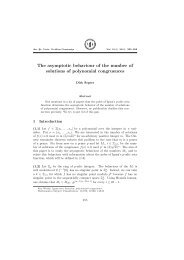the irrationality of sums of radicals via cogalois theory
the irrationality of sums of radicals via cogalois theory
the irrationality of sums of radicals via cogalois theory
- No tags were found...
Create successful ePaper yourself
Turn your PDF publications into a flip-book with our unique Google optimized e-Paper software.
22 Toma Albuas x = p n 11 · . . . · pn kk , where k ∈ N∗ , p i are distinct positive prime numbers,and n i ∈ Z \ {0} for all i, 1 i k. Because n√ x ∈ I, by Lemma 2.4, wecannot have n | n j , ∀ j, 1 j k, so <strong>the</strong>re exists i, 1 i k, with n ∤ n i ,as desired.Assume that <strong>the</strong> condition (1) is satisfied, i.e., x ∈ I. Then necessarilyn√ x ∈ I, for o<strong>the</strong>rwise it would follow that x = (n √ x ) n ∈ Q, which contradictsour assumption. Assume now that <strong>the</strong> condition (2) is satisfied. By Lemma2.4, we deduce thatn √ x ∈ I, which finishes <strong>the</strong> pro<strong>of</strong>.Proposition 2.5 provides a large class <strong>of</strong> irrational numbers. For instance,because 4 ∤ 1.√ √4 1001134 = 4 22 · 5 22 · 3 4 · 7 = 4√ 2 1 · 3 −4 · 5 2 · 7 −1 ∈ IThe next examples deal with <strong>the</strong> <strong>irrationality</strong> <strong>of</strong> <strong>sums</strong> <strong>of</strong> two or threesquare or cubic <strong>radicals</strong> <strong>of</strong> positive rational numbers, which naturally lead toask about <strong>the</strong> general case <strong>of</strong> <strong>the</strong> <strong>irrationality</strong> <strong>of</strong> <strong>sums</strong> <strong>of</strong> finitely many n-th<strong>radicals</strong> <strong>of</strong> positive rational numbers.Examples 2.6. (1) √ 2 + √ 3 ∈ I. Indeed, denote u := √ 2 + √ 3 and supposethat u ∈ Q. Now, square u − √ 2 = √ 3 to obtain u 2 − 2u √ 2 + 2 = 3. Sinceu ≠ 0, we deduce that √ 2 = u2 − 1∈ Q, which is a contradiction.2u(2) √ 2 + 3√ 3 ∈ I. Indeed, as above, denote v := √ 2 + 3√ 3 and supposethat v ∈ Q. If we cube v − √ 2 = 3√ 3, we obtain v 3 − 3 √ 2 v 2 + 6v − 2 √ 2 = 3,and so √ 2 = v3 + 6v − 33v 2 ∈ Q, which is a contradiction.+ 2(3) Similarly, with <strong>the</strong> same procedure, one can prove that for a, b, c ∈ Q ∗ +<strong>the</strong> following statements hold:√ a +√b ∈ Q ⇐⇒√ a ∈ Q &√b ∈ Q,√ a +3 √ b ∈ Q ⇐⇒ √ a ∈ Q & 3√ b ∈ Q,√ a +√b +√ c ∈ Q ⇐⇒√ a ∈ Q &√b ∈ Q &√ c ∈ Q.






